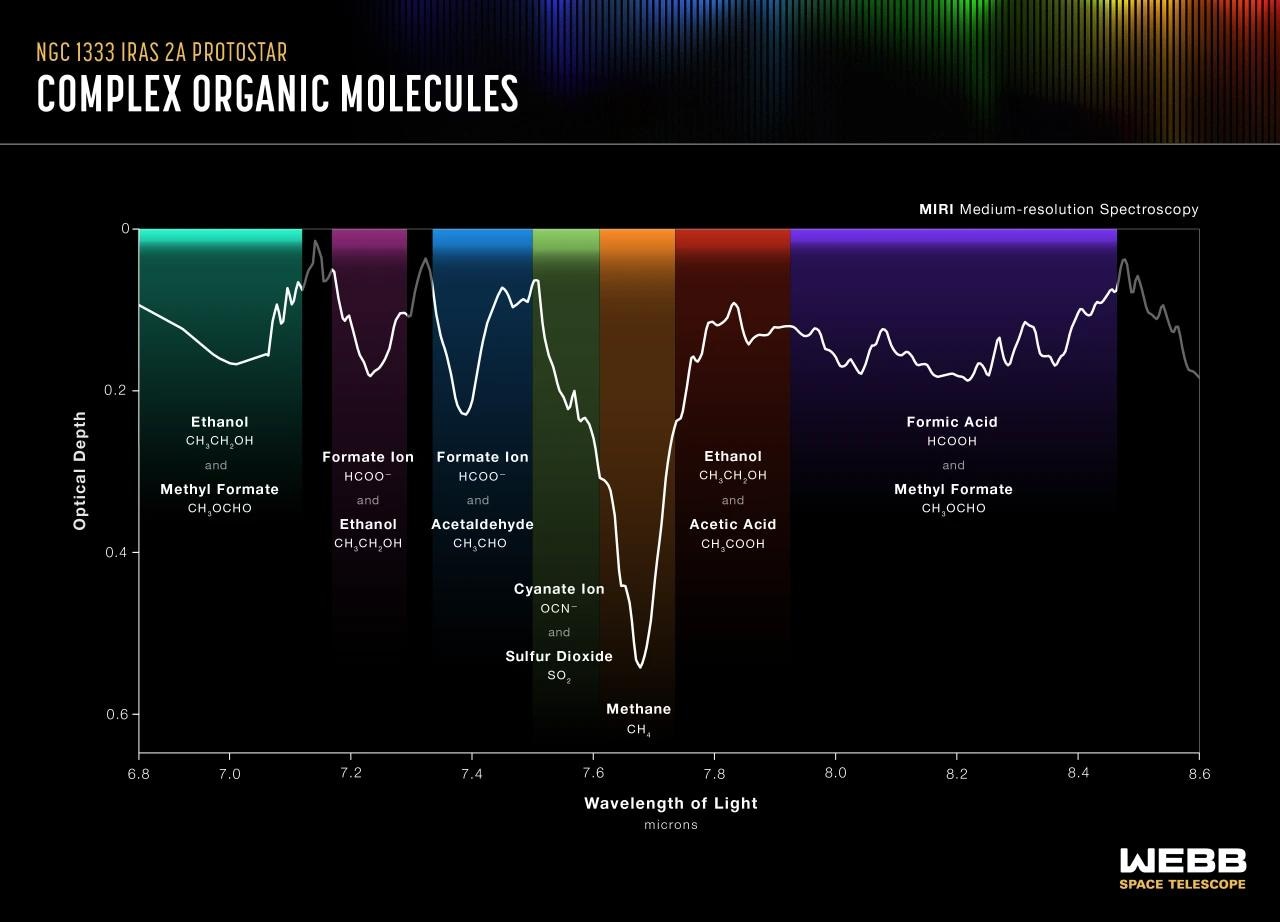Reviewed by Lexie CornerMar 14 2024
What is the connection between ant stings, vinegar, and margaritas? They include chemical components that NASA's James Webb Space Telescope has discovered surrounding two young protostars, IRAS 2A and IRAS 23385. While planets have not yet formed around those stars, these and other molecules found by Webb are essential components for creating possibly habitable worlds.
 NASA’s James Webb Space Telescope’s MIRI (Mid-Infrared Instrument) has identified a variety of complex organic molecules that are present in interstellar ices surrounding two protostars. These molecules, which are key ingredients for making potentially habitable worlds, include ethanol, formic acid, methane, and likely acetic acid in the solid phase. The finding came from the study of two protostars, IRAS 2A and IRAS 23385, both of which are so young that they are not yet forming planets. Image Credit: NASA, ESA, CSA, L. Hustak (STScI). Science: W. Rocha (Leiden University).
NASA’s James Webb Space Telescope’s MIRI (Mid-Infrared Instrument) has identified a variety of complex organic molecules that are present in interstellar ices surrounding two protostars. These molecules, which are key ingredients for making potentially habitable worlds, include ethanol, formic acid, methane, and likely acetic acid in the solid phase. The finding came from the study of two protostars, IRAS 2A and IRAS 23385, both of which are so young that they are not yet forming planets. Image Credit: NASA, ESA, CSA, L. Hustak (STScI). Science: W. Rocha (Leiden University).
Using Webb's MIRI (Mid-Infrared Instrument), an international team of astronomers identified several icy compounds consisting of complex organic molecules, such as acetic acid, an ingredient in vinegar, and ethanol (alcohol). This work expands upon earlier Webb discoveries of a variety of ices within a frigid, dark molecular cloud.
What is the Origin of Complex Organic Molecules (COMs)?
This finding contributes to one of the long-standing questions in astrochemistry...What is the origin of complex organic molecules, or COMs, in space? Are they made in the gas phase or in ices? The detection of COMs in ices suggests that solid-phase chemical reactions on the surfaces of cold dust grains can build complex kinds of molecules.
Will Robson Monteiro Rocha, Team Leader, Leiden University
Since a number of COMs, including the ones found in this study's solid phase, were previously found in the warm gas phase, it is currently thought that ice sublimation is where COMs originate.
Sublimation is the direct, non-liquid transition from a solid to a gas. Astronomers are keen to gain a better understanding of the origins of other, even larger molecules in space after discovering COMs in ice.
The extent to which these COMs are transported to planets at much later stages of protostellar evolution is another topic that scientists are eager to investigate. Cold ice COMs are believed to be easier to transport than warm, gaseous molecules from molecular clouds to planet-forming disks.
Therefore, these icy COMs can be integrated into comets and asteroids, which may then collide with planets in the process of formation, providing the necessary elements for life to potentially flourish.
Simpler compounds like sulfur dioxide, formaldehyde, methane, and formic acid, which cause the burning sensation of an ant sting, were also found by the scientific team. According to research, sulfur-containing substances like sulfur dioxide were crucial in propelling metabolic processes on the early Earth.
Similar to the Early Stages of Own Solar System?
The fact that IRAS 2A, one of the sources under investigation, is classified as a low-mass protostar is especially intriguing. Thus, IRAS 2A might resemble the early phases of the solar system.
Therefore, it is possible that the compounds found in the vicinity of this protostar were present during the early phases of the solar system's formation and were later transported to the early Earth.
All of these molecules can become part of comets and asteroids and eventually new planetary systems when the icy material is transported inward to the planet-forming disk as the protostellar system evolves, and we look forward to following this astrochemical trail step-by-step with more Webb data in the coming years.
Ewine van Dishoeck, Co-Ordinator, Leiden University
James Webb Observations of Young ProtoStars, or JOYS+, is the program for which these observations were made. The results were dedicated to Harold Linnartz, a team member who unexpectedly passed away in December 2023, not long after this paper was accepted.
The research was published in the journal Astronomy & Astrophysics.
Journal Reference:
Rocha, W. R. M., et al. (2024) JWST Observations of Young protoStars (JOYS+): Detecting icy complex organic molecules and ions. Astronomy and Astrophysics. doi.org/10.1051/0004-6361/202348427